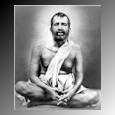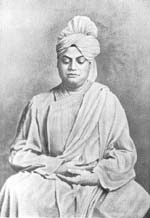Renaissance was Swami Ramakrishna, who defended Hinduism against Western criticism and utilized fundamentals of religion and philosophy from the West. Eventually Ramakrishna blended elements of Kali worship, Vaisnavism, Tantrism and Vedanta into his own teaching, which was later communicated
to Americans through his student Swami Vivekananda.
 Founder:
Swami Ramakrishna
Founder:
Swami Ramakrishna
Swami Ramakrishna was born to a poor Brahmin family as Gadadhar Chattopadhyaya
in West Bengal on February 18, 1836. He had mystical experiences at the
early age of six. At sixteen, Ramakrishna left his home with his brother
and ended up in Dakshineswar, where his brother worked as a chief priest
at the Dakshineswar temple and Ramakrishna began his passionate worship
of Kali. However, at this time people began to doubt his mental sanity.
Upon hearing Ramakrishna's condition, his mother arranged for him to return
to his village and marry five-year-old Saradamani
Mukhopadhyaya. (They did not live together until Ramakrishna
had joined monastic life later on in his life.) During the 1860s Ramakrishna
was spiritually trained under several teachers in Tantrism and Advaita
Vedanta. He also explored Western religions, including Islam and Christianity.
Ramakrishna is said to have become a Muslim for three days and to have
merged with Muhammad and later with Jesus. The Brahmo Samajists and other
contemporary reformers recognized Ramakrishna's extraordinary spirituality.
He passed away in 1886 of throat cancer.
 Missionary:
Swami Vivekananda
Missionary:
Swami Vivekananda
Though representing the same Vedantic message Swami Vivekananda carried
a distinctive disposition. Formally educated in Western and Eastern
philosophies, Vivekananda was an active reformer. Before joining
the Ramakrishna Movement he was a member of the Brahmo Samaj reform movement
in India. At his first visit with Ramakrishna, at the age of 18, he was
both fascinated and repulsed by Ramakrishna. However Vivekananda eventually
became loyal to his teacher. Following Ramakrishna's death, Vikekananda's
main objective became humanitarianism. Viewing the Parliament of Religions
of 1893 as an opportunity to spread the truth of Vedanta outside of India,
the swami decided to represent Hinduism in Chicago. He was praised highly
for his lecture at the Parliament and remained in the United States lecturing
for the next two years. In this way, Vikekananda carried the Vedanta movement
to the West, where conceptions of Hinduism were shifting from unfavorable
missionary accounts to more positive representations.
Teachings and Beliefs
Based on Upanishadic philosophy and Neo-Hindu reinterpretations, Vedanta
encompasses several important teachings. First is the existence of Brahman,
an impersonal deity described only as Sat-chit-ananda (Absolute
existence-knowledge-bliss). In the United States Brahman was equated
to God. Second is the existence of the transcendental Self, Atman, as a
microcosmic manifestation of Brahman. The Vedantists believe the potentiality
for divinity is within oneself, and when Brahman is perceived to be Atman
("Tat tvam asi":"That are thou") the Self attains moksha, or liberation.
Vedantists recognize four paths to liberation: karma yoga (the path of
selfless work), bhakti yoga (the path of devotion), jnana yoga (the path
of knowledge) and raja yoga (the path of formal meditation). During the
movement's early years, jnana yoga appealed most to the educated followers.
But bhakti yoga was also a popular means of achieving liberation.
Through the adoption of shakti (the power of consciousness and spiritual evolution usually associated with females) worship, Vedanta offers females more authority, and as a result most followers before World War I were females. The acceptance of different religious faiths has been a key characteristic of Vedanists. As a Hindu reformer, Ramakrishna did not claim that any one religious faith was the right path to God. Accordingly, Jesus has been adopted as a yogi (a practitioner of yoga) figure in the movement.
Worldwide Presence
During the late nineteenth century, Vedanta Societies throughout the
United States attracted wealthy, educated followers, most female and foreign-born.
The first Vedanta center was opened in New York City in 1894, and eventually
most major cities in the United States housed a Vedanta Center. Successful
centers emerged in Boston, San Francisco, and Los Angeles while efforts
in Philadelphia, Washington D.C. and Denver failed.
Unlike other new religious movements, Vedanta societies have not used
media to advertise their teachings and practices. Vedanta has been spread
by word of mouth, so membership has always stayed low. In 1906 there were
a total of 360 members. After 1920, however, Vedanta Societies have stagnated.
In 1991 total membership was a mere 2,500. With an increase of Indian immigrants
seeking "ethnic enclaves," Vedanta is at risk of losing
its native American following.
Reference:
Jackson, Carl T. Vedanta for the West: The Ramakrishna Movement
in the United States (Indiana University Press, 1994).
